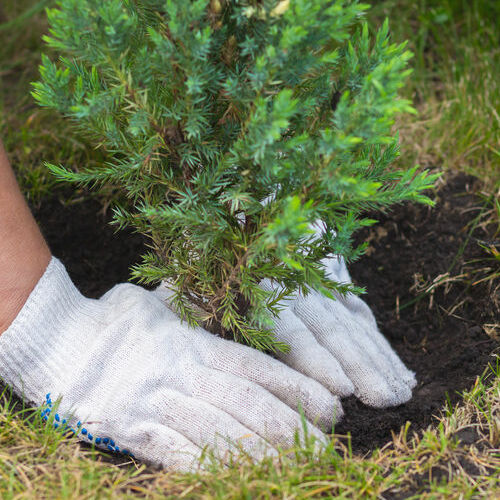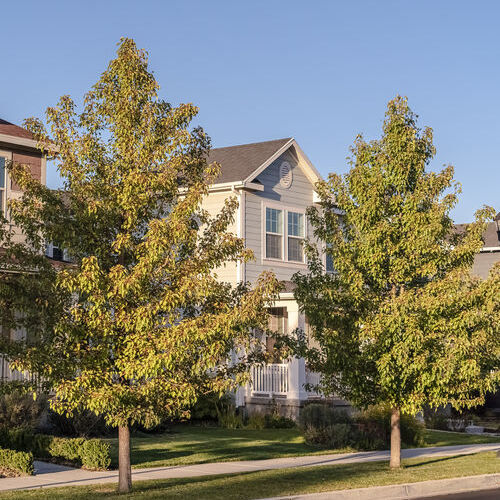
What is the best time to plant a tree?
While you might think spring is the ideal time to plant trees, it’s generally best to plant them in the fall. Tree planting times may vary, however, depending on where you live and what kind of tree you’re planting. For the most part it’s best to plant the tree in either late August or early September or October in temperate areas. Even those months are relative, depending on where you live. You want to plant when it genuinely begins to feel cool, which in Texas could be as late as the middle of October or early November. Cooler weather encourages good root growth. Colder weather and freezes, as well as the scorching weather of summer, can damage trees and limit growth.
There are some trees like pines or other evergreens that you can plant in either the spring or fall because they don’t go dormant. Fruit trees can be planted in either the spring or fall depending on how severe your winter is. If you have severe winters, then the spring is best, while in milder winters, you can plant in the fall. Some popular trees used in landscaping like birch, willow, dogwood or magnolia trees should be planted in the spring, and watered properly throughout the summer, because they need more time to get established.
If you are planning to plant trees some time during the year, or have trees as part of your landscaping, you want to make sure those trees are trimmed and well cared for. For expert tree care in Dallas-Fort Worth, TX count on the professionals at MDM Landscapes. We offer a full range of tree care and landscaping services. Find out more by calling 817-396-0125.
What is the purpose of planting trees?
Tree planting has a variety of purposes. With so much talk about the environment and climate change, you may wonder, “Does planting a tree help the environment?” The simple answer is, “yes.” They produce oxygen and absorb carbon dioxide. They help manage flooding and soil erosion. They help control the climate, moderating the sun’s effects, rain and wind, and serve as nesting places and food sources for a variety of animals. They also serve as a food source for humans, including fruits like apples and oranges, as well as nuts like pecans.
Trees are also essential for landscaping in both commercial and residential environments. Not only do they help prevent soil erosion and flooding, they impact our homes, providing shade in the summer that affects cooling costs. You may wonder about the economic benefit of planting trees and wonder, “Is tree planting worth it?” Along with reducing energy costs in the summer, trees have great economic value when it comes to private property. Trees, for instance, improve the curb appeal of homes, and great landscaping can increase a home’s sale price by 6% to 7%. Great landscaping can increase the property value by 20%.
What trees can be planted close to a house?
When planting trees, you need to have a strategy when it comes to selecting trees to plant near your home. Certain trees like white ash, maple and poplar have large root systems that could damage your pipes and foundations. You want to plant trees that have small root systems. Some popular trees to plant near the house include:
- Crabapple
- American hornbeam
- Cornelian cherry dogwood
- Japanese maple
- Flowering dogwood
- American holly
How far away from a house should a tree be planted?
Tree planting can be a complicated process when you’re landscaping. A major consideration is how far away you should plant your trees from your home. While trees provide great shade and can reduce cooling costs in the summer, there are some species like poplar or white ash you want to plant far away from your home. These trees have large or aggressive root systems that can damage your pipes or foundation. In fact the size of the root system, as well as its height and width when it’s fully grown will determine where you place it in relation to your home. Tree roots can spread out as much as three times its crown’s width.
Larger trees that grow 70 feet or more should be planted at least 20 feet from the home, while a medium-size tree that reaches a height of up to 70 feet tall should be at least 15 feet from the home. But even smaller trees that are under 30 feet tall should be at least eight to 10 feet away from the home. For most average size one-story homes, smaller and medium height trees are usually best. Large trees in front of a smaller home can make the home look even smaller. Although larger trees like oaks are very popular, smaller trees, even with larger homes can often enhance the landscaping better, and put your home at less risk of damage.
Tree planting and aftercare
Of course, once the trees have been planted you’ll have to care for them properly to ensure they grow into healthy adult trees. Tree planting and watering is a key to the tree’s survival. Making sure young trees get enough water, especially in the summer, is essential. Before the first leaves reach full size the tree should be watered at least 4 to 5 times per week, and every day in the summer. Of course, make sure to follow any summertime water usage restrictions set down by city ordinances.
Your young tree also needs to have adequate soil. They’ll compete with grass and weeds for the soil, so a small turf-free space should be kept around the tree as it grows. Thick mulch should also be added to the soil to control weed growth, compaction, erosion, and will conserve moisture. In the past, extensive pruning was recommended. Now only light or no pruning is recommended. Pruning at this stage should be primarily used to shape and train the tree. This should be done at three years of age, and a tree care service like MDM Landscapes can help with this service to ensure it’s done properly. You also want to regularly inspect the tree for pests and disease.

Tree planting near me
When it comes to tree care, among the many services MDM Landscapes provides is tree planting as well as after care. We offer a full range of tree care and landscaping services. Find out how we can help or schedule our services by calling 817-396-0125.
